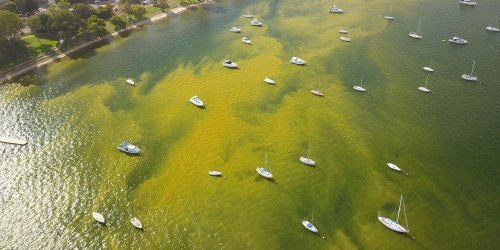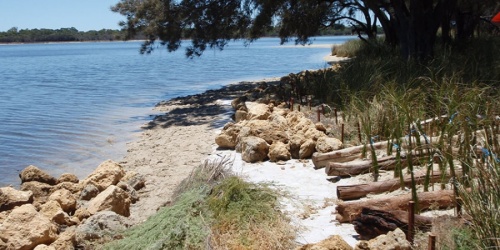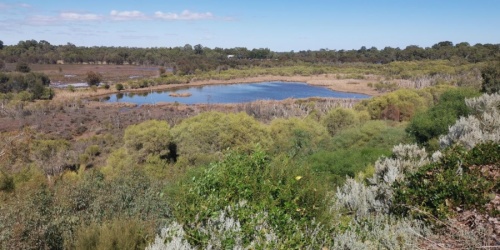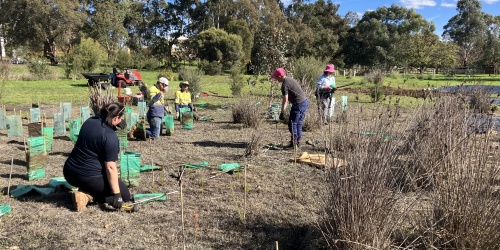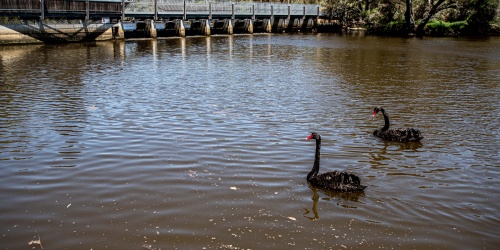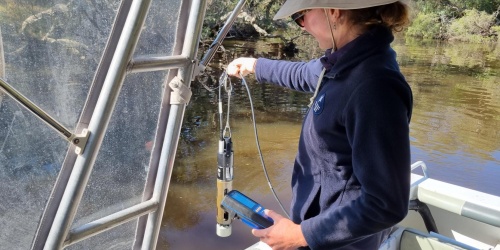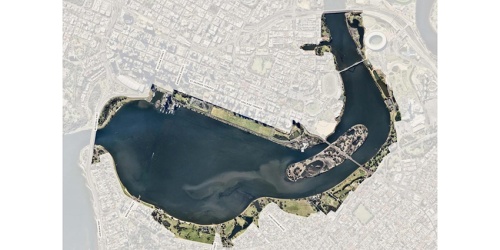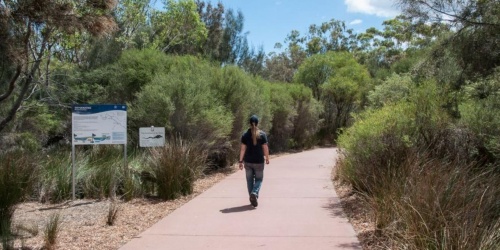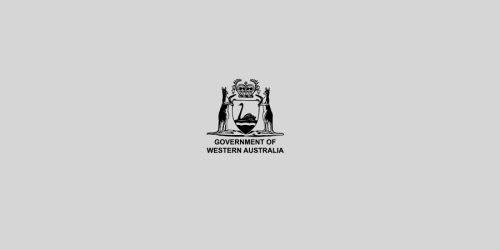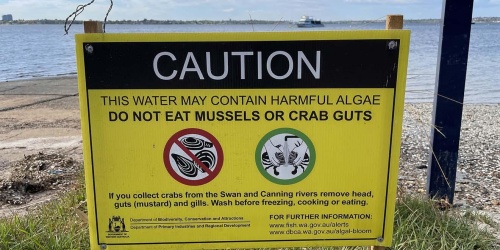
Waterways support a wide array of important habitats. These include open water, sand shallows, tidal mudflats, tidal samphire marshes, fringing sedges and rushes, fringing woodlands, submerged macrophytes, seagrass and macroalgae, riffles and pools, marine intertidal zones, woody debris and interconnected wetlands.
Artificial structures (e.g. jetties, groynes and posts) provide additional habitat.
Natural disturbance events such as fires, floods and storms often impact these habitats, which can recover through regeneration and recolonisation by species spreading from nearby areas. However, if the scale of disturbances is too great or where multiple threatening processes exist simultaneously, species and communities may be affected and biodiversity may decline.
Processes that continue to pose a threat to habitats and biodiversity in the Riverpark include:
- Development pressure
- Water quality changes
- Erosion
- Diminished flow
- Climate change
- Invasive plants and animals
DBCA aims to minimise the impacts of these stressors and protect habitat by addressing water quality and ecological health, managing development pressure, ensuring adequate environmental flow and responding to climate change. It partners with foreshore land managers to improve habitat and reduce erosion pressure and invasive weeds through improved foreshore management.
DBCA is a signatory to the Biosecurity Charter and supports the Department of Fisheries to manage invasive fauna in the Riverpark.
Foreshores are dynamic boundaries between land and water and are constantly changing in response to natural geomorphic processes and shifts in natural conditions in the surrounding catchment.
Human disturbance can affect the integrity of foreshores through:
- loss of fringing vegetation through clearing and damage
- erosion exacerbated by boat wake and surface water run-off
- weed invasion by non-local native species
- uncontrolled public access
In the Swan Canning Riverpark, foreshores comprise two main types:
- natural shorelines that support fringing vegetation and have important habitat value
- built foreshores that employ a range of engineered stabilisation mechanisms to protect important infrastructure or provide high value amenity.
Protection and rehabilitation of foreshores is critical maintain environmental and socio-economic values within the Riverpark. An assessment of shoreline condition in 2008 as part of the Swan and Canning Rivers Foreshore Assessment and Management Strategy determined that:
- at least 146km of foreshore was experiencing moderate to high erosion
- approximately 6km of foreshore retaining structures required immediate maintenance
Parks and Wildlife has a number of initiatives to protect and rehabilitate foreshores.
- The Riverbank Program sees Parks and Wildlife work in partnership with 21 local and six State Government agencies that are jointly responsible for the management of the Swan Canning Riverpark shoreline.
- The Boating Management Strategy aims to limit the impact of boat wash on some sensitive foreshore areas. The strategy guides the management of boating in the Swan Canning Riverpark and includes recommendations to ensure the sustainable future of this popular pastime. Two specific recommendations include:
- Aquatic Use Review Management Framework,a systematic review of aquatic activities in the Swan and Canning rivers undertaken jointly by the Swan River Trust (now Department of Biodiversity, Conservation and Attractions) and the Department of Transport – Marine Safety in response to the increasing level of use in the rivers. The intent of the draft framework is to ensure safe, equitable and sustainable use of the waterway with minimal conflicts.
- Dinghy Management Policy, which formalises the recommendations of the Boating Management Strategy requiring dinghies to be stored in an approved management system, protecting sensitive shorelines and improving public safety and access.
- Tree damage response involves Parks and Wildlife officers thoroughly investigating any deliberate tree damage in the Swan Canning Riverpark in consultation with land managers.
- Guidelines for developing foreshore management plans and foreshore restoration plans in the Swan Canning Riverpark, which have been prepared to support appropriate planning and management strategies for the foreshore.
- Best management practices for foreshore stabilisation, which documents current best management practices in foreshore stabilisation for the Swan and Canning rivers.
- Swan and Canning Rivers Foreshore Assessment and Management Strategy was developed in 2008 through a partnership with the Australian Government, Natural Heritage Trust and the Swan Catchment Council. The strategy is still in use and provides an ecological and physical assessment of the Swan and Canning river foreshores. It documents information on condition and pressures on the foreshores and recommended management responses. The strategy is divided into a foreshore assessment and a management strategy.
Riverbank Program
The Riverbank Program protects and enhances the Swan and Canning river foreshores. Its objectives include:
- To protect and enhance riverbanks and shorelines to mitigate threats to environmental, recreational, aesthetic or cultural values;
- To protect, enhance and manage fringing native vegetation and habitat; and
- To improve the enjoyment of the foreshore by addressing risk to public amenity values, infrastructure and the environment.
Riverbank initiatives
Riverbank Funding
Riverbank Funding initiates and funds foreshore protection and rehabilitation works on public land through partnerships with State and local government. Since the Riverbank Funding program's inception in 2002, the State Government has contributed almost $31 million across Riverbank projects. This has been matched by riverside foreshore land managers across more than 360 projects sites, and in total represents a more than $60 million investment in the health and amenity of the Riverpark.
The 2025-26 funding round is now open. Visit the Apply for Riverbank funding webpage for more information.
Proactive
Proactive funding allows priority shoreline areas to be targeted with large projects that may span many years. Unlike the Grants scheme, sites for proactive funding are selected through a set of assessment criteria to priority sites. Once selected, State and local government agencies are proactively approached to develop partnerships and project plans. Partnership arrangements and project schedules between Parks and Wildlife and the land manager are defined in legal collaborative arrangements.
Items funded through the Proactive scheme must be consistent with the objectives of the Riverbank Program and contribute to improving the condition of shorelines and reducing the impact of threatening processes on biodiversity, infrastructure, cultural and/or social amenity values.
Swan Canning Riverpark foreshore risk identification and mapping project
DBCA is undertaking a foreshore risk identification and mapping project for the Swan Canning Riverpark. The project will identify erosion, inundation, and climate risks for the Riverpark, which includes the Swan River (Derbal Yerrigan) and the Canning River (Djarlgarro). Risk mapping will illustrate anticipated foreshore hazards over a 100-year planning period. Understanding erosion and inundation risk across the Riverpark is essential for future foreshore planning and management in the context of a changing climate. The best available science will be applied across the Riverpark to produce technically sound data and mapping which will support improved risk management decision-making by illustrating likely long-term trends, and demonstrating where existing practices may be challenged.
Key project activities include:
- assessment of local foreshore change, including interactions between the riverbed, bank structure, vegetation, and human activities, under changing conditions
- modelling and system-wide analyses of waves, hydrodynamics, and sediment dynamics, integrated with local-scale assessments of foreshore dynamics
- climate data processing, including down-scaled climate change projections for Perth region, to describe future scenarios
- forecasts of inundation and erosion hazards including key local drivers, with active and emerging processes
- risk mapping of projected inundation risk and erosion hazard (2025 to 2125), and identification of assets at risk
The project will be delivered in a phased way, with final reporting and workshops anticipated in 2025.
Results from the project will be communicated to public foreshore land managers through a series of interactive workshops, for specific river reaches of the Riverpark. Their input will help to manage and mitigate current and future risks to Riverpark assets. Further information on final project outcomes and the workshops will be provided early 2025.
Should you have any questions, please email Riverbank Program at riverbank@dbca.wa.gov.au.
DBCA acknowledge support of the following project partners and sponsors:
- Project delivery - Seashore Engineering and the University of Western Australia.
- Project funding - Commonwealth Government and the WA State Emergency Management Committee.
Swan Canning Riverpark Urban Forest program
In March 2021, the McGowan Government committed $3 million in funding over four years (2021-22 to 2024-25) to the Swan Canning Riverpark Urban Forest program. The program supports public land managers to deliver urban forest restoration projects within the Riverpark including tributaries and drainage lines in the Swan Canning catchment. This is a unique opportunity, with funding available for projects that address the following priorities:
- Improved condition, structure and function of urban forest ecosystems in the Riverpark and along drainage lines and tributaries in the Swan Canning catchment
- Improved habitat value and increased use by native fauna through revegetation
- Improved management of the Swan Canning Riverpark urban forest by State and local government
- Improved water quality entering the river
- Improved Riverpark amenity and use by Perth residents and visitors.
Applications for funding can be made at any time during the year and will be assessed to ensure they meet established criteria. Public land managers are encouraged to discuss project ideas with DBCA’s Urban Forest Coordinator, who can be contacted on 9278 0900 or riverbank@dbca.wa.gov.au to arrange an online appointment or site visit. The Swan Canning Riverpark Urban Forest program grant opportunity guidelines are available in the downloads section below. This initiative is part of the WA Government’s Kep Katitjin-Gabi Kaadadjan (Waterwise Perth action plan 2) to establish leading waterwise communities for Boorloo (Perth) and Bindjareb (Peel) by 2030.
Best management practices for foreshore stabilisation
The best management practices for foreshore stabilisation aim to improve shore stabilisation management in the Swan Canning Riverpark.
Riverbank Extension Plan
The Riverbank Extension Plan provides information, support and training to State and local governments directly responsible for the planning and implementation of foreshore restoration and erosion control projects in the Swan Canning Riverpark.
Foreshore Assessment and Management Strategy
The Riverbank Program has been working in the Swan Canning river system since 2010 to develop a management system that assesses the value of shorelines in protecting assets and geomorphology and providing riparian ecology and amenity value to Western Australians.
The Riverbank Shoreline Management System documents type, extent, condition and value the entire 330kms of Swan Canning natural and built shorelines. This Management System enables analysis of shorelines via asset management systems, asset-threat-response models, and social impact assessment of facilities. The system results in up-to-date data collation, immediate priority identification, clear risk communication, value for money financial resource distribution.
Local Government users can now access DBCA datasets that are restricted to use by LGAs, via the Shared Location Information Platform (SLIP). Four Datasets are available from www.data.wa.gov.au
- Swan Canning Riverpark Built Foreshores 2022 (DBCA-065)
- Swan Canning Riverpark Natural Foreshores 2023 (DBCA-067)
- Swan Canning Foreshore Useability 2021 (DBCA-068)
- Swan Canning Riparian Ecology Foreshores 2019 (DBCA-066)
Queries can be directed to Riverbank officers at riverbank@dbca.wa.gov.au or (08) 9278 0900
Fringing vegetation
Importance of fringing vegetation
Fringing (or riparian) vegetation is an integral part of a riverine ecosystem and includes the terrestrial and emergent vegetation that borders and is influenced by the waterway. Fringing vegetation provides food and shelter for many bird species and other small animals.
A dense network of roots enables fringing vegetation to stabilise riverbanks and protect them against erosion from boat wash, river flow and surface water run-off.
Fringing vegetation helps to reduce nutrients and sediment entering waterways by slowing the rate of overland runoff, enabling sediments to settle and nutrients to be trapped and used on land.
Overstorey species provide shade to waterways and reduce water temperature. They also drop leaves, bark and insects into the waterway, providing food to aquatic invertebrates and fish. Woody debris in the form of fallen trees and branches provide structure, food and habitat along the shoreline. Woody debris provides important shelter for fish and helps deflect erosive forces away from the banks.
How is fringing vegetation lost?
Riparian vegetation is reduced or removed from a foreshore through disturbance including:
- Trampling
- Unmanaged access for fishing or vessel launching
- Weed invasion
- Clearing
- Grazing
- Poor foreshore vegetation maintenance
What happens when fringing vegetation is lost?
Grasses and weeds often replace native fringing vegetation, and often have only shallow roots making the banks more vulnerable to the hydraulic forces that cause erosion. Bank undercutting and slumping can occur which contribute to increased sedimentation of waterways. More rapid runoff increases nutrients and sediment entering the waterways.
In-stream light availability and temperature increase without overstorey shading and, where nutrients are available, encourages the growth of submerged aquatic plants, periphyton (the collection of organisms such as algae and bacteria that live on the surface of submerged plants and other underwater objects) and filamentous algae. Where plant growth is excessive it can increase the amount of decomposing organic matter instream, reducing oxygen levels. In-stream plant growth also helps to trap sediments moving downstream, promoting channel infilling and smothering habitat.
Reduction in terrestrial insects, woody debris and leaf litter in-stream and increased growth of submerged plants, periphyton and filamentous algae changes habitat and food for fish and invertebrate communities. This reduces diversity, with degraded waterways often dominated by fewer species.
Protecting foreshore vegetation
It is an offence under the Swan and Canning Rivers Management Regulations 2007 to damage vegetation in the Swan Canning Riverpark or Development Control Area (DCA). Parks and Wildlife encourages appropriate planning and development in the DCA and has a range of planning control measures and processes to facilitate and evaluate development applications around the rivers, depending on where the development is located.
Occasionally foreshore vegetation is damaged by people who did not realise they needed a permit to carry out maintenance. However, in some cases, trees have been systematically poisoned, have had their limbs removed or are cut down. Tying boats or dinghies damages foreshore vegetation and is an offence.
Responding to tree damage
Parks and Wildlife regularly receives complaints from the public about deliberate foreshore vegetation damage in the Riverpark. These are thoroughly investigated in consultation with land managers.
Offenders may face penalties of up to $5000 under the Swan and Canning Rivers Management Regulations 2007.
Signs are installed at some tree damage sites to educate the community about the value of vegetation and encourage reporting of tree damage.
Generally new trees are planted and damaged trees left standing (as long as it is safe to do so) while the new tree grows.
How you can help
The public are encouraged to report any acts of environmental vandalism to Parks and Wildlife on 9278 0900, or after hours on 0419 192 845.
Erosion
River and estuary foreshores are dynamic places. In the Swan Canning Riverpark, foreshores respond to seasonal variations in water level, storm surges, wave action, sediment flux, tidal currents and river flow.
Landward movement of foreshores (erosion) can affect human amenity value and threaten valuable infrastructure. Offshore movement of foreshores (accretion) may affect navigation, smother benthic habitats and decrease channel carrying capacity.
Problems with foreshore movement generally occur when instability threatens social, environmental or economic values. Much of Perth is built on reclaimed foreshores and there is a history of locating important infrastructure close to the river without adequate setback. In order to protect that infrastructure from erosion, river walls and revetments have been built along shorelines. These are often inadequate due to their age, insufficient maintenance or inappropriate design for the conditions.
The presence of trees and sedges helps to naturally stabilise foreshores by reducing bank sediment mobility and buffering erosion from wave action and river flow. Widespread clearing for urban and agricultural activity means foreshore vegetation often exists as only a single line of mature trees bordering the river. This provides no room for vegetation retreat and makes the vegetation itself vulnerable to erosion.
Waves derived from boat wakes that exceed the intensity and duration of natural waves also undermine fringing vegetation. Structures on foreshores such as drains can disturb natural sediment transport patterns along shorelines. Discharge from drains on to or above riverbanks can also undermine bank stability.
Addressing erosion in the Riverpark
Through the Riverbank Program, Parks and Wildlife is working in partnership with 21 local and six State Government agencies to address localised areas of erosion.
Addressing boat wake
The cumulative increase in vessel wake can damage riverbanks and infrastructure and adversely affect other aquatic users. With an increase in boat ownership in Perth and greater proportions of large recreational vessels, the effects of boat wash on shorelines stability is becoming increasingly topical. However, it should be noted that in some areas of the river, affects from boat wash may have less influence on shoreline erosion than tidal movements, wind waves and drainage.
In 2009, research and trials were undertaken to investigate boat speeds and wash in the Riverpark.
Based on these results a speed reduction from 8 knots to 5 knots was introduced to the upper Swan River upstream of Belmont Ski area in November 2011. The speed reduction is expected to reduce shoreline erosion and damage to wildlife habitat. It also reduces conflict between boat users and other users of the river.
The results have also been used to help inform a major review of aquatic usage on the Swan and Canning rivers in the Aquatic Use Review and Management Framework.
Invasive plants and animals
Invasive species are the greatest threat to Australia’s biodiversity after habitat loss. Once established, invasive species can alter an ecosystem and reduce local biodiversity. New species may be competitors, disturbers, consumers, or prey. They can cause local extinctions through predation, competitive exclusion, niche displacement and altered genetics of native species. The Swan Canning Riverpark is widely affected by affected by introduced weeds, fish and invertebrates.
Weeds
A weed is an alien or introduced plant that is invasive. Weeds on the foreshore and in the water can be a serious problem for the Swan Canning Riverpark, competing with local plants for space and light. They usually don’t suffer from pests or diseases, and animals may not feed on them, so they spread easily. They can overtake the natural vegetation, reducing native species diversity and habitat value.
Foreshore weeds mostly come from nearby gardens, farmland and market gardens. Seeds are blown or washed into bushland near streams and into drains leading to streams. Birds can introduce them in droppings and people often thoughtlessly dump garden waste containing seeds, bulbs or cuttings in bushland near the river.
Aquatic weeds may clog the waterway with their own biomass or by causing sediment build up. Stagnant waters are more likely to be deprived of oxygen, causing the death of aquatic life. Habitats for birds and other animals may be lost, recreational areas ruined and irrigation pumps clogged with plant material.
Invasive fish
Invasive fish species Swan Canning Riverpark include pearl cichlids (Geophagus brasiliensis), goldfish (Carassius auratus), koi carp (Cyprinus carpio), mosquito fish (Gambusia holbrookii), silver perch (Bidyanus bidyanus), spangled perch (Leiopotherapon unicolour) and redfin perch (Perca fluviatilis). Their introduction and spread can cause problems in waterways as they flourish, breed and compete with native species.
Introduced fish can:
- establish feral populations that compete for food such as crustaceans, insects and plants, or feed directly on native fishes, causing native species to decline
- become aggressively territorial, reducing available habitat for native fish and other water dwelling animals, and exhibit aggressive behaviors – such as fin nipping – that can seriously injure or kill native fish
- introduce parasites and spread disease that may affect native fish and other freshwater animal life
- alter habitats by digging in riverbeds, uprooting plants and muddying the river: this can increase the level of nutrients in the water and may lead to excessive algae growth
The Department of Fisheries is the lead agency for managing feral fish.
Many exotic fish common in the aquarium trade are hardy and have wide environmental tolerances and will survive and thrive in our local waterways. Pearl cichlids (Geophagus brasiliensis), a popular aquarium fish native to coastal rivers of Brazil and Uruguay, were first found in the Bennett Brook in March 2006 and are now well established in the upper Swan and Canning rivers.
Introduced invertebrates
Three invertebrate species introduced to the Swan Canning Riverpark are described here.
- The Australian mud whelk (Batillaria australis) is a large marine snail with a persistent shell that disturbs soil and sediment and is widely distributed at a very high abundance. It is likely to be impacting the ecology and biogeochemical cycling of the river.
- The Asian paddle crab (Carybdis japonica), also known as lady crab, is a swimming crab native to South East Asia (normally found in the waters of Japan, Korea and Malaysia) typically found in estuaries. It is not known to have established in Australian waters. Four individuals have been found in the lower Swan estuary since 2012.
- The white sea squirt (Didemnum perlucidem) is an invasive colonial tunicate that has established sustaining populations around a number of ports in Western Australia. It remains listed as a marine pest and suspected and confirmed detections should be reported so its distribution can be tracked. Growth of this species appears to be highly seasonal. It can grow very fast in favourable conditions and is known to foul mussel beds and artificial structures. In the Swan Canning Riverpark it has been observed fouling seagrass meadows.
Managing invasive fauna
In Western Australia, the Department of Fisheries is the lead agency responsible for responding to and managing invasions of introduced fish and invertebrates. Actions are often a cooperative approach between the departments of Parks and Wildlife, Fisheries and Water, local government authorities and other major stakeholders.
How you can help
The community’s help is needed to curb the spread of invasive species in the Swan Canning Riverpark and the wider catchment.
The Department of Fisheries has launched a Don’t Dump that Fish campaign to promote awareness of the damage aquarium species can cause if they are released.
